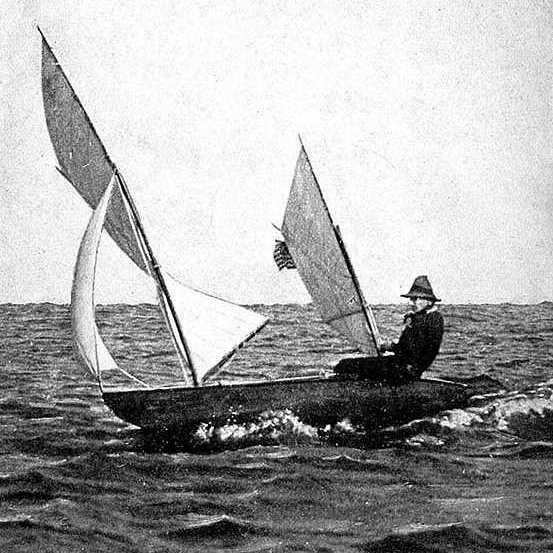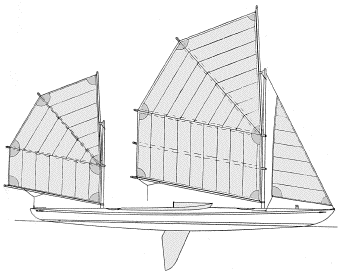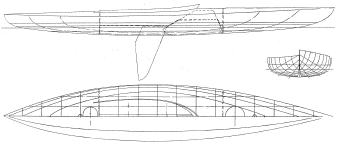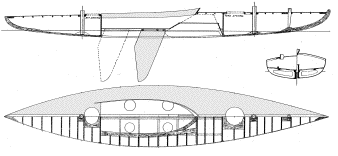|
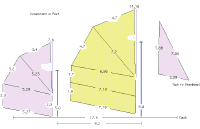 |
Approximate dimensions. You have to love these batwing sails. |
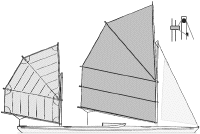 |
Sail plan, after Yachting Monthly. |
The Bruce Mines Museum
Open seasonally: the original Yakaboo is there. They still haven't gotten the word about Yakaboo's actual builder.
Mystic Seaport Museum
In the manuscript collections at the Blunt Library you can see assorted documents from Fenger's trip, the manuscript version of Yakaboo's log, and a typescript of the logbook. There is much other Fenger material but it seems to be all related to his later experiments in hull shape and sail rig. Nevertheless it's interesting to read over the logbook.
Joe Youcha's Replica and Further Reading
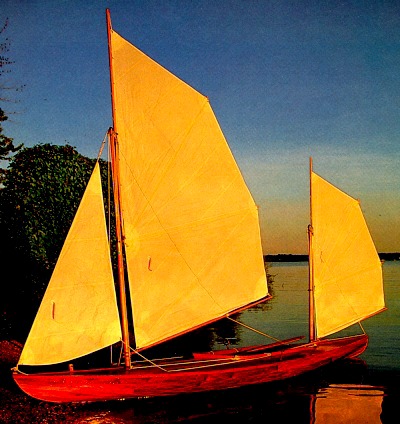 |
Joe's replica at sunset. Joe is associated with the Alexandria Seaport Foundation. A Bequia whaleboat is under restoration at ASF, too. Photo: Chris Kulczycki. |
WoodenBoat #82, page 5: (letter about Yakaboo by John Martsolf).Sail and Oar by John Leather: one chapter discusses rudderless boats including Yakaboo.
I haven't yet seen:
Yachting (USA) - July 1914 and July 1919.Nor the original Outing series, which I'll have to see on microfilm, I guess.
A Canoe in the Caribbean.
Yachting Monthly (UK)
Vol. 31 -- July 1921.
The editorial comments are, I assume, from Maurice Griffiths.
Some time ago I promised to obtain information regarding the canoe in which Mr. Fenger made his remarkable voyage among the Caribbean Islands. Here are the plans which he has very kindly sent to me from Massachusetts, and as they were not published in his book they should be of world-wide interest. While the many voyages in large boats are wonderful in their way, Mr. Fenger's exploit was almost unique. I use the word "almost," for one must not forget Tilicum, the incredible canoe in which Captain Voss went round the world. She, of course, was large enough, but she was a canoe, a dug-out, and an ungainly brute. How he ever navigated her puzzles me to this day.
Mr. Fenger, however, is an expert canoeist, but anyone who wishes to read of his voyage must do so for themselves in "Alone in the Caribbean," published in America by George Doran in 1917, when its author was serving with the U.S. Navy in European waters.
The Yakaboo comes from a family of canoes which Mr. Fenger started 20 years ago, and I take the following description from his book :--
"She did not look her length of 17 feet and with her overhangs would scarcely be taken for a boat meant for serious cruising. Upon close examination, however, she showed a powerful midship section that was deceiving, and when the natives lifted her off the horses -- "O Lard she light !" -- herein lay the secret of her ability. Her heaviest construction was in the middle third, which embodied fully half her total weight. With her crew and the heavier part of the outfit stowed in this middle third she was surprisingly quick in a seaway. With a breaking sea coming head on, her bow would ride the foamy crest, while her stern would drop into the hollow behind, offering little resistance to the rising bow.She had no rudder, the steering being done entirely by the handling of the main sheet. By a novel construction of the centerboard and the well in which the board rolled forward and aft on sets of sheaves, I could place the center of lateral resistance of the canoe's underbody exactly below the center of effort of the sails, with the result that on a given course she would sail herself. Small deviations such as those caused by waves throwing her bow to leeward, or sudden puffs that tended to make her luff, were compensated for by easing off or trimming in the mainsheet. In the absence of the rudder-plane aft, which at times is a considerable drag to a swinging stem, this type of canoe eats her way to windward in every squall, executing a "pilot's luff" without loss of headway, and in puffy weather will actually fetch slightly to windward of her course, having more than overcome her drift.
She was no new or untried freak, for I had already cruised more than a thousand miles in her predecessor, the only difference being that the newer boat was nine inches greater in the beam. On account of the increased beam it was necessary to use oars instead of the customary double paddle. I made her wider in order to have a stiffer boat, and thus lessen the bodily fatigue in sailing the long Channel runs.
She was divided into three compartments of nearly equal length -- the forward hold, the cockpit, and the afterhold. The two end compartments were accessible through watertight hatches within easy reach of the cockpit. The volume of the cockpit was diminished by one half by means of a watertight floor raised above the waterline -- like the main deck of a ship. This floor was fitted with circular metal hatches through which I could stow the heavier parts of my outfit in the hold underneath. The cockpit proper extended for a length of a little over six feet between bulkheads so that when occasion demanded I could sleep in the canoe."
The dimensions I have put on the plans. While not being most efficient, the rig was chosen because of the short spars and ease in reefing and handling. How even an experienced canoeist could travel so far and so fast in such a boat, and without a rudder, will puzzle many. It was a wonderful undertaking, and Mr. Fenger deserves credit for his navigation and his clever little craft.
SAIL AND RIGGING PLAN
SCALE 1/4" = 1ft. Sail Area = 80 sq ft
Click the pic for a much larger image.
LINES OF THE SAILING CANOE YAKABOO,
DESIGNED BY F.A. FENGER
LOA 17ft • LWL 14.16ft • Beam 3.25ft
Draught:
unloaded, but with the crew on board, 4-1/4"
loaded 5-1/4 to 6"Displacement (hull and mahogany centerboard) 147 lbs
Spars and Sails 25 lbs.
Click the pic for a much larger image.
GENERAL ARRANGEMENT AND CONSTRUCTION PLANS
OF THE SAILING CANOE YAKABOO, SHOWING THE
MOVABLE CENTERBOARD AND STOWAGE ARRANGEMENTS
Click the pic for a much larger image.
West Indian Beach Punt
From Élisée Reclus, The Earth and its Inhabitants, North America / edited by A.H. Keane. New York : D. Appleton, 1890-1893. A drawing of the same type punt appears in American Small Sailing Craft by Chapelle. Fenger does not mention this type of boat, but it's unusual and apparently not well documented. The original volumes in French date from 1880-85 or so.(761x537 pixels)
Map
From Down the Islands by Wm. A. Paton, an account of a trip through the Caribbean in a steamer in the 1880s. Not very interesting once you've read Fenger but a few nice illustrations. Princeton University holds a collection of Paton's artwork and photos.(823x1311 pixels)
Map
From Reclus, above. See also Fragment of a Voyage to Louisiana, where Reclus writes of sailing through the Caribbean in about 1852.(1041x834 pixels)
More
Caribbean Compass, December 1999
- An Historical Overview of Yachting in the
- Lesser Antilles in the 20th Century,
- as Revealed in Bibliographical Highlights
- by Richard Dey
••NOTES••CONTENTS••
Copyright Y2K Craig O'Donnell, Boat-ologist
